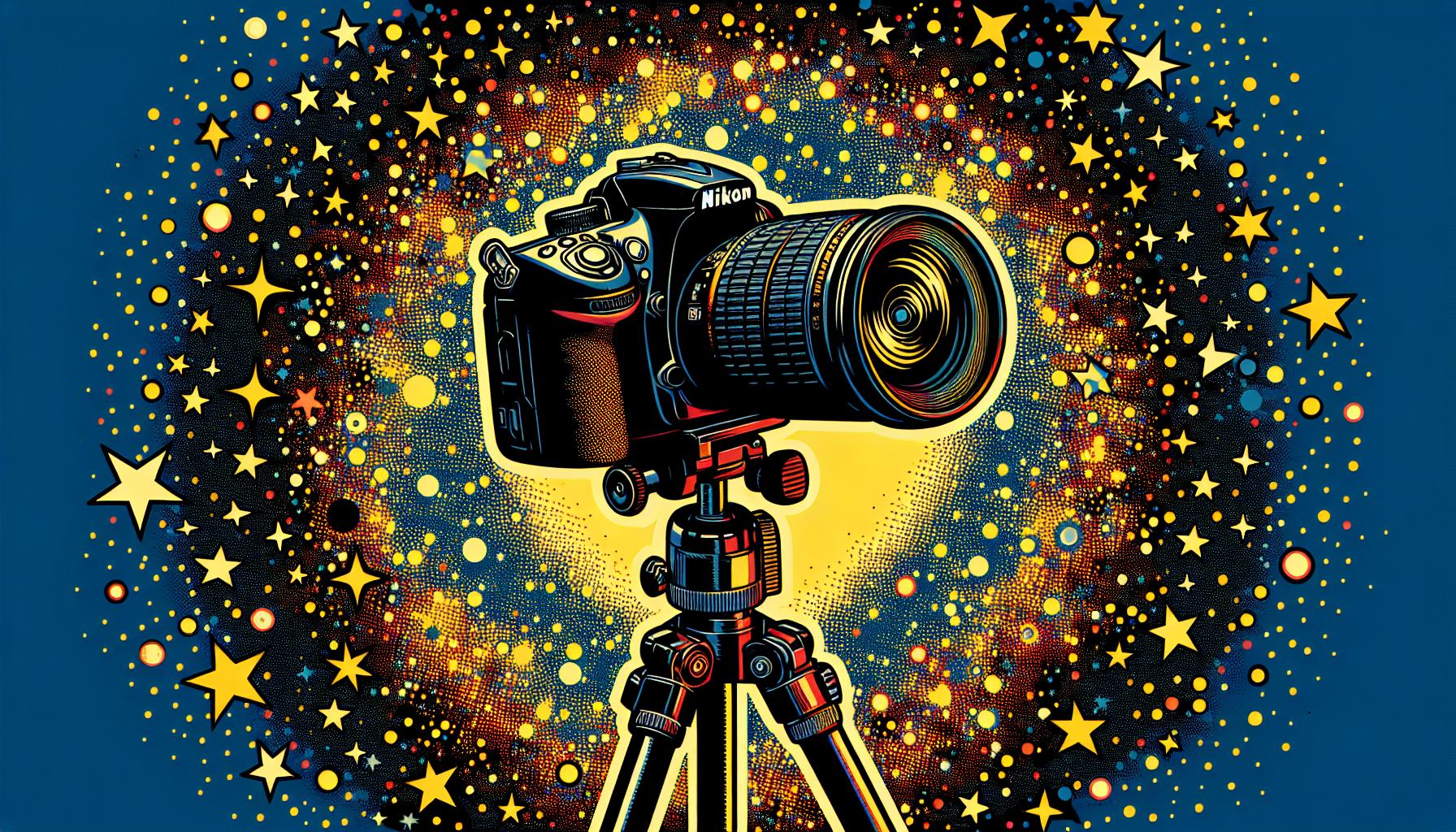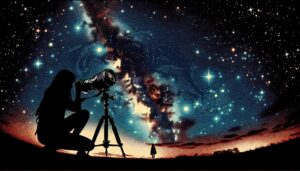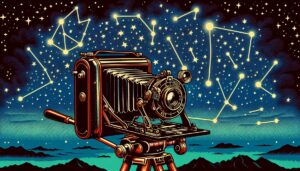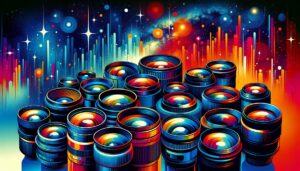This site contains affiliate links to products. I may receive a commission for purchases made through these links.
If you’re looking to delve into the mesmerizing world of astrophotography, the Nikon D3500 is a fantastic choice. I’ve found it to be an affordable yet powerful DSLR that’s perfect for capturing the night sky in all its glory.
The D3500’s high-resolution sensor, combined with its impressive low-light capabilities, allows you to capture stunning images of stars, galaxies, and other celestial wonders. Plus, its ease-of-use makes it the perfect choice for beginners and pros alike.
In the upcoming sections, I’ll be sharing some tips and tricks on how to get the most out of your Nikon D3500 for astrophotography. Whether you’re a seasoned stargazer or just starting out, you’re sure to find this guide helpful.
Understanding Astrophotography
Astrophotography! It’s an exotic term, isn’t it? But it’s essentially as simple as taking pictures of heavenly bodies. It involves capturing images of night skies, including stars, galaxies, and other astronomical wonders. This craft combines an individual’s love for photography and the wonders of the universe.
While astrophotography might seem challenging at first glance, it’s not as complex as you might think. With the right tools, such as the Nikon D3500, and some creativity, anyone can capture beautiful images of the starry night skies.
Astrophotography can be divided into different categories:
- Wide-field astrophotography: Involves capturing images of large portions of the sky using a traditional camera and lens. That’s like taking photos of constellations and capturing “star trails.”
- Telescopic astrophotography: This is more complex and involves capturing images of celestial objects through a telescope. Great for capturing images of distant galaxies or the moon’s craters.
The most fascinating about astrophotography is that it lets you capture what the naked eye can’t see. With the long exposures used in this form of photography, you can reveal the hidden wonders of the universe.
Learning the art of astrophotography can be an adventure, a journey of discovery into the beauty and mystery of the cosmos. While it requires patience and a bit of practice, the results can be truly breathtaking. Remember, gear is an important aspect, and a user-friendly camera, such as the Nikon D3500, can certainly help your journey into astrophotography.
In the upcoming sections, we’ll explore more about the Nikon D3500 camera, its features that make it ideal for astrophotography, and some useful tips to maximize your experience.
Stay tuned and continue exploring the wonders of astrophotography with us.
Why Choose the Nikon D3500?
In the realm of astrophotography, the Nikon D3500 stands tall as a steadfast companion. Let’s delve into the specifics of why this beauty is an exquisite choice for both beginners and avid astrophotographers.
Firstly, it packs a whopping 24.2 megapixel DX-format CMOS sensor that works tirelessly to ensure each of your shots are sharp, clear and generously detailed. When you’re trying to capture the vastness of a starlit night sky, such megapixel power can make a world of difference. Moreover, the D3500’s sensor is APS-C sized, offering a 1.5x crop factor that extends the reach of your lens, an essential feature when delving into celestial photography.
Let’s talk about light – the lifeblood of photography. With an ISO range extending from 100 to 25,600, the Nikon D3500 excels in low-light scenarios, making it primed for night-time photography. Additionally, being equipped with a wide dynamic range, it balances highlights and shadows proficiently, ensuring that your nighttime photos are fully detailed and balanced in exposure.
Besides the technical aspects, Nikon D3500 is lightweight and compact, making it portable for those long treks under the night sky. Coupled with a strong battery life, it’s as reliable as it gets.
Lastly, being user-focused is where D3500 truly shines. Its user-friendly interface makes it an ace pick among beginners, and its compatibility with a wide range of lenses adds to its appeal. And let’s not forget the in-camera Guide Mode – think of it as your personal photography tutor. It’s designed to help you learn and improve your photography skills on the go. Also, with the Nikon D3500, you can shoot continuously at a speed of 5 frames per second, giving you a better chance to capture those elusive celestial moments.
Below is a quick recap of why Nikon D3500 could be your go-to camera for astrophotography:
- 24.2 megapixel DX-format CMOS sensor
- APS-C size sensor with a 1.5x crop factor
- ISO range of 100 to 25,600
- Excellent dynamic range
- User-friendly and compatible with a variety of lenses
- In-camera Guide Mode and 5 fps continuous shooting
- Lightweight and strong battery life
Key Features of the Nikon D3500 for Astrophotography
In the vast cosmos of cameras well-suited for astrophotography, the Nikon D3500 emerges as a constellation of its own. What exactly makes it that way? It’s the powerful blend of high-resolution capture, extraordinary low-light performance, and stunning dynamic range in a compact and affordable package.
Boasting a 24.2-megapixel DX-format CMOS sensor, this digital SLR captures images with sharp, rich detail. The sheer resolution pack ensures that star-studded night skies are imprinted with utmost accuracy.
| Feature | Benefit |
|---|---|
| 24.2-megapixel DX-format CMOS sensor | High-resolution images |
Another extraordinary attribute of the D3500 lies in its low-light capabilities. It offers an impressive ISO range of 100-25,600, which means it can easily adapt to varying light conditions. The expansive ISO range caters to the varying light levels of astrophotography, even in the depths of night.
| Feature | Benefit |
|---|---|
| ISO 100-25,600 | Superior low light performance |
Adding more to its portfolio, the Nikon D3500 exhibits a wide dynamic range that finely balances highlights and shadows. Result? The camera captures brilliant celestial patterns while preserving the nuances of dark space – a quintessential requirement of astrophotography.
| Feature | Benefit |
|---|---|
| Wide dynamic range | Well-balanced highlights and shadows |
The camera’s lightweight and compact design make it a portable companion for night-time photography adventures. Don’t overlook the strong battery life—it’ll keep up with you until the starry night fades away.
| Feature | Benefit |
|---|---|
| Lightweight and Compact | Convenient for night-time photography |
| Strong battery life | Longer photography sessions |
Where the Nikon D3500 truly shines is in its user-friendly interface which means you won’t need to be a seasoned pro to take good photos. It’s combined with a significant degree of customization, In-camera Guide Mode to assist beginners, and an impressive 5 fps continuous shooting. Its compatibility with diverse lenses further amplifies its use in astrophotography.
| Feature | Benefit |
|---|---|
| In-camera Guide Mode and user-friendly interface | Seamless and guided experience for beginners |
Tips for Shooting Astrophotography with the Nikon D3500
To take breathtaking astrophotography shots with the Nikon D3500, there are some specific tips and settings that you can apply. These tips can greatly enhance your experience when using this camera to photograph celestial bodies in the night sky.
Firstly, shooting in Manual mode (M) is my recommendation when dealing with astrophotography. It gives you full control over your settings. These settings include ISO, shutter speed, and aperture – all crucial for capturing stunning images of the night sky. Remember, astrophotography is about balancing the sensitivity of your sensor (ISO), the amount of light entering your camera (aperture), and how long that light is allowed to hit the sensor (shutter speed).
The Nikon D3500 features an ISO range of 100-25,600. For astrophotography, it’s best to start at an ISO of 6400, adjusting it if necessary to get the correct exposure. The correct exposure means your photo isn’t too light (overexposed) or too dark (underexposed). Note though that a higher ISO may result in more noise in your images.
Next, set your aperture to the widest (lowest f-number) setting. This allows as much light as possible to get into your camera. The shutter speed should be set to 20 seconds as this will allow enough time to capture the stars as pinpricks of light and not as trails. You should adjust according to the level of starlight movement that you like.
Another tip involves focusing. Auto-focus is generally less reliable in the dark hence manual focus (MF) is recommended for astrophotography. You can use the live view feature on the D3500 to magnify a bright star and then adjust the focus ring until the star appears sharpest.
From my experience, using a tripod and a remote shutter release or the camera’s timer function is also vital. These help eliminate shake and guarantee crystal-clear images.
Lastly, shooting in raw format (instead of JPEG) will give you more flexibility during post-processing. Remember, processing your night sky pictures is crucial in astrophotography. It allows you to bring out the subtlety of the stars and the Milky Way that your camera has captured.
In a nutshell, mastering these techniques and settings can offer an immersive astrophotography experience with the Nikon D3500.
Post-Processing Techniques for Astrophotography with the Nikon D3500
After you’ve taken your shots with the Nikon D3500, the real magic begins. Post-processing is essential to unveiling the full details of your night sky shots. By working with programs such as Adobe Lightroom and Photoshop, I can significantly elevate the quality of my astrophotography. Let’s dive into some beneficial tips for post-processing.
Adjusting the exposure and white balance is an important first step. It’s pivotal to bring out the stellar details without introducing too much noise. For the Nikon D3500, Lightroom has a preset specific to Nikon RAW files, which I find particularly helpful.
Manipulating the color balance to achieve a more natural starry night effect is another consideration. It’s possible to tame the overwhelming orange hues of city lights or the strong blue cast of moonlight.
Reducing noise and increasing clarity are also crucial steps. Using the Detail tab in Lightroom, I usually set the noise reduction between 25 to 50. Clarity can then be boosted to around the 30-40 mark.
One of my most utilized tools for astrophotography post-processing is the dehaze function. In the Presence section of the Basic tab, you have this powerful feature that can dramatically cut through night sky haze. It can embellish those starry details you’ve worked hard to capture with your Nikon D3500.
Lastly, creating a punchy contrast between the sky and the stars can make the image come alive. Subtly tweaking the ‘Blacks’ will darken the night sky while being careful not to lose important details.
Astrophotography with the Nikon D3500 isn’t complete without a bit of post-processing magic. Even with the perfect settings, locations and clear skies, raw images need a bit of extra help. With the post-processing techniques I’ve outlined, you are well-prepared to take your astrophotography to a whole new level.
Conclusion
So, it’s clear that the Nikon D3500 is a solid choice for astrophotography. With the right settings and techniques, you’ll find it’s more than capable of capturing the night sky in all its glory. Don’t forget, shooting is just half the battle. Post-processing plays a crucial role in bringing out the fine details and colors of your starry shots. Tools like Adobe Lightroom and Photoshop can be your best allies in this journey.
Whether you’re a beginner or a seasoned astrophotographer, the D3500, paired with these tips, can help you reach new heights in your celestial photography endeavors. The night sky is an amazing canvas, and with the Nikon D3500, you’re well-equipped to paint it with stars.




